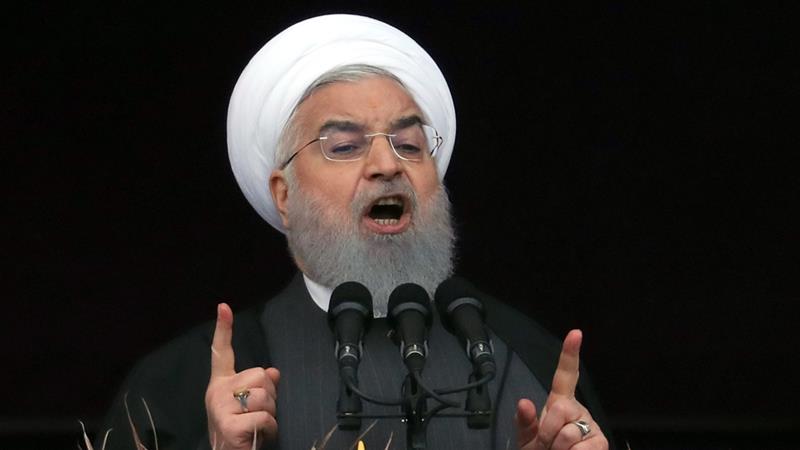Home » Middle East »
Rouhani unveils Iran's cruise missile-equipped Fateh submarine
Vessel equipped with modern guided-missile system and is capable of operating underwater for up to five weeks.
Iranian President Hassan Rouhani has unveiled a “state-of-the-art” domestically produced submarine, which the defence ministry said is capable of firing cruise missiles.
Rouhani is in the southern province of Hormozgan on Sunday to introduce the latest addition of the naval fleet.
Dubbed the Fateh, or Conqueror, it is the country’s first semi-heavy submarine, according to Mehr news agency.
In his speech to thousands of supporters at the port city of Bandar Lengeh before the submarine launch, Rouhani warned against the division in the country, saying that is the goal of Iran’s enemies.
“We will not bow down to the hegemonic power. We are ready to sacrifice ourselves and spill our blood to protect Iran,” he said.
Mehr news reported that the 600-tonne submarine launched on Sunday is equipped with torpedoes and naval mines, and can operate more than 200m below sea level for up to five weeks.
Tasnim news agency added that the Fateh is also outfitted with a guided-missile system capable of launching submarine-launched cruise missiles and an advanced sonic radar system that can identify enemy vessels.
“The Fateh is entirely a homegrown submarine that is designed and developed by experts of the defence ministry and is equipped with the world’s modern technologies,” Brigadier General Amir Hatami, the defence minister, was quoted by Tasnim on Saturday as saying.
The Fateh is the latest addition to Iran’s fleet of submarines, which was first launched about 20 years ago.
Hossein Dalirian, a defence reporter for Tasnim news agency, noted in a social media post that the latest submarine is one of the most important projects Iran’s military have undertaken in the last 40 years.
Another Tehran-based security analyst, who asked not to be identified because of the sensitivity of the topic, noted that the submarine’s vertical launching system.
He said it is a “very important news” as only a few countries have the kind of “advance system”.
He also said that 1,300-tonne and 3,200-tonne submarines are also in the production agenda of the armed forces.
“With four torpedoes, Fateh has the fastest firing system,” the analyst said, adding that the vessel is also equipped with four torpedo boats, eight mines and two reserve torpedoes, aside from the cruise missiles.
In the past, Iran had bought three submarines from Russia. But because of the low depth of the waters off Iran, it became difficult to manouever those vessels, prompting the Iranian Navy to design and launch its own line of submarine in 2006, the analyst said.
The commander-in-chief of the Iranian Navy, Rear Admiral Hossein Khanzadi, has been quoted as saying that the Fateh submarine will be used to carry out a mission in the Oman Sea.
‘Deterrent factor’
The move is the latest show of military strength by Iran, as it marks the 40th anniversary of the Islamic Revolution at a time of heightened tensions with the United States.
Maysam Bizar, a Tehran-based journalist and political observer, said that while it is an “old tradition” in Iran to launch new military equipment during the anniversary of the revolution, Sunday’s unveiling of the submarine takes a more significant meaning.
“There are definitely messages, which are being conveyed to Washington, DC,” Bizar told Al Jazeera, saying it could well be a “deterrent factor” by Iran against US warships in the region.
The US and other European countries have repeatedly warned against Iran’s missile programme. The US has claimed that the missiles are capable of carrying nuclear warheads.
Iran’s missile programme is not covered by the 2015 nuclear agreement with world powers, and Tehran insists that it is purely for defensive purposes. UN nuclear inspectors have also said that Iran is not pursuing any nuclear weapons and has continued to abide by the nuclear agreement.
Since the US decision to withdraw from the 2015 deal and reimpose sanctions, Iran has ramped up its missile development.
Earlier this month, Iran announced that it successfully tested a new cruise missile, Hoveizeh, with a range of up to 1,350km.
Days later, it also unveiled a surface-to-surface missile, the Dezful, with a shorter range of 1,000km.
Iran has so far set a 2,000km limit to its missiles – a range capable of reaching Israel and Western military bases in the Middle East, but not the US. According to experts, an Iranian missile requires a 10,000km range to reach the US.
The US has pointed to these recent missile activities in its efforts to convince Europe and other countries to withdraw from the nuclear deal.
But Europe has resisted the pressure, saying that staying within the nuclear deal gives it more diplomatic leverage to convince Iran to curb its missile programme.
Source: Read Full Article



